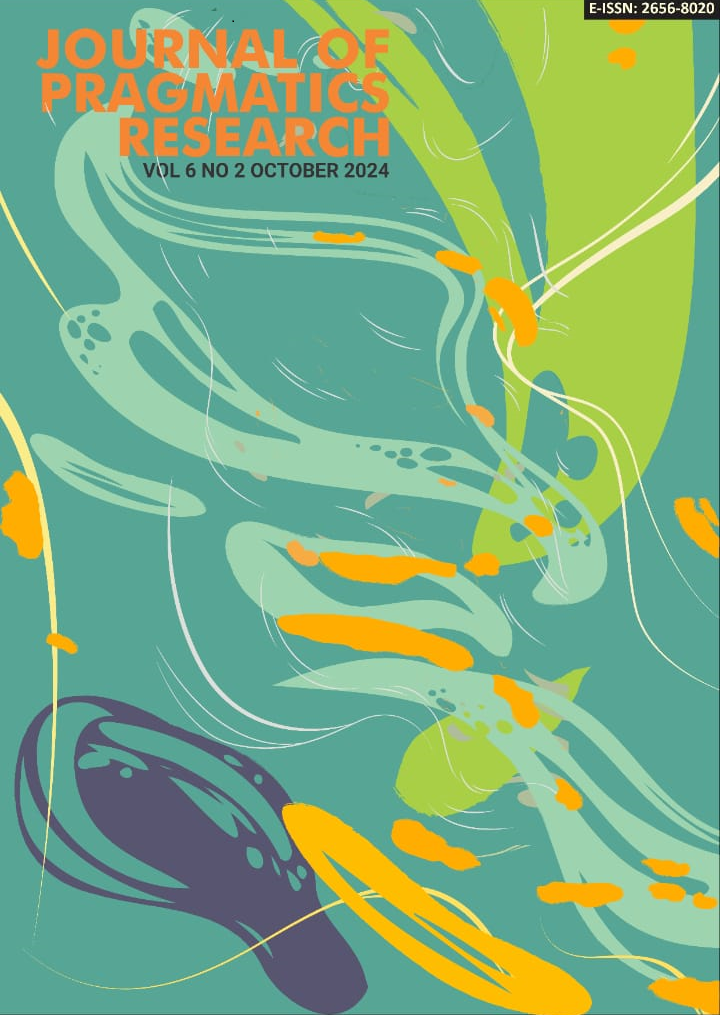The Function of Hedge ~to omou in verbal interaction Yuriko Koike: Analysis in Interview from NTV News Channel
DOI:
https://doi.org/10.18326/jopr.v6i2.169-185Abstract
Hedges are an important linguistic feature in interpersonal communication to make communication run effectively. One of the hedges widely used in Japanese verbal interaction is ~to omou. Hedges ~to omou shows the speaker's subjectivity and the intersubjectivity that emphasizes the addressee's point of view. Intersubjectivity is related to the social function of using hedges. This article explains the social function of hedges ~to omou used by Japanese politician Yuriko Koike in an interview on the theme ‘female parliamentarians in Japan’. The analysis of the social function of hedges is carried out based on the concept proposed by Lauwereyns. Data collection was carried out using the listening and recording method, and the data were then classified and analyzed based on Lauwereyns's concept regarding the social function of a hedge. The social function of hedge ~to omou is supported by other hedges with similar functions in utterances. The results of this study indicate that in utterances containing criticism and suggestions, Hedge ~to omou tends to have the social function of politeness and solidarity. While in an utterance containing opinions
References
Asano, Y. (2007). Semantic analysis of tag questions in Japanese: Desho and janaika. Selected Papers from the 2007 Conference of the Australian Linguistic Society. Conference of the Australian Linguistic Society. http://www.als.asn.au. 2008
Bong, L. (2018). Cultural Differences in the Use of Hedges in Japanese and Korean― Case Study of “omou” and “sayngkakhata.” 北海商科大学論集, 7(1).
Davies, R. J., & Ikeno, O. (Eds.). (2002). The Japanese mind: Understanding contemporary Japanese culture. Tuttle Pub.
Demiyati, L. (2018). Pemagaran Hedging dalam Pidato Politik Perdana Menteri Jepang Shinzo Abe [Universitas Indonesia]. : https://lib.ui.ac.id/detail?id=20467804&lokasi=loka
Habeeb, S. (2019). Hedging Strategies and Politeness in the Political Interview. 6, 131–147. https://doi.org/10.13140/RG.2.2.20675.35369
Hirose, M., & Kakuko, S. (2001). Kodansha’s Effective Japanese Usage Dictionary. Kodasha International Ltd.
Hotta, T., & Horie, K. (2018). L2 acquisition of the Japanese verbal hedge omou: A prototype approach. In Cognitive Linguistics and Japanese Pedagogy: A Usage-Based Approach to Language Learning and Instruction (pp. 199–224). De Gruyter Mouton.
Iori, I. dkk. (2002). Chujoukyuu wo Oshieru Hito no tame no Nihongo Bunpou Handobukku. 3A Network.
Koike Yuriko Official Website. (n.d.). Profile. Koike Yuriko Official Saito. Retrieved March 2, 2023, from https://www.yuriko.or.jp/profile
Lauwereyns, S. (2000). HEDGES IN JAPANESE SPOKEN DISCOURSE: A COMPARISON BETWEEN YOUNGER AND OLDER SPEAKERS [Dissertation]. Michigan State University.
Maynard, S. K. (1993). Discourse Modality -Subjectivity, Emotions and Voice in The Japanese Language. John Benjamins Publishing Company.
Maynard, S. K. (1997). Japanese Communication. Language and Thought in Context. University of Hawaii Press.
Maynard, S. K. (2005). Nihongo Kyouiku no Genba de Tsukaeru. Kurushio Shuppan.
Mi, L. E. (2018). The usage of ‘Omou’ in conversations between university female students: Focusing on ‘Omou’ as hedge. The Japanese Language Association of Korea, 58, 165–182.
NTV News, Y. (2021, November 18). Josei to Seiji” Nihon no Josei Giin naze sukunai? Koike Tochiji Dokuten Intabyuu [Interview]. https://www.youtube.com/watch?v=RZXgoJQsd_U
Ogi, N. (2017). Involvement and Attitude in Japanese Discourse Interactive Marker. John Benjamins Publishing Company.
Onodera, N. (2004). Japanese Discourse Markers: Synchronic and Diachronic Discourse Analysis. John Benjamins Publishing Company.
Sunagawa, Y. (2005). Kyoushi to Gakushuusha no tame no Nihono Bunkei Jiten. Kuroshio Shuppan.
Tanaka, L. (2010). IS FORMALITY RELEVANT? JAPANESE TOKENS HAI, EE AND UN. International Pragmatics Association, 20(2), 191–211. https://doi.org/DOI: 10.1075/prag.20.2.04tan
Traugott, E. C. (2003). From subjectification to intersubjectification. In Motives for language change (pp. 124–139). Cambridge University Press.
Vlasyan, G., R. (2019). Linguistic Hedging in Interpersonal Communication. The European Proceedings of Social & Behavioural Sciences, 617–623. 30 This is an Open Access article distributed under the terms of the Creative Commons Attribution-Noncommercial 4.0 Unported License, permitting all non-commercial use, distribution, and reproduction in any medium, provided the original work is properly cited. https://doi.org/10.15405/epsbs.2019.08.02.72
Downloads
Published
How to Cite
Issue
Section
License
Copyright (c) 2024 Parwati Hadi Noorsanti

This work is licensed under a Creative Commons Attribution-ShareAlike 4.0 International License.
License and Copyright Agreement
In submitting the manuscript to the journal, the authors certify that:
- They are authorized by their co-authors to enter into these arrangements.
- The work described has not been formally published before, except in the form of an abstract or as part of a published lecture, review, thesis, or overlay journal.
- That it is not under consideration for publication elsewhere,
- That its publication has been approved by all the author(s) and by the responsible authorities – tacitly or explicitly – of the institutes where the work has been carried out.
- They secure the right to reproduce any material that has already been published or copyrighted elsewhere.
- They agree to the following license and copyright agreement.
Copyright
Authors who publish with JOURNAL OF PRAGMATICS RESEARCH agree to the following terms:
- Authors retain copyright and grant the journal right of first publication with the work simultaneously licensed under a Creative Commons Attribution License (CC BY-SA 4.0) that allows others to share the work with an acknowledgment of the work's authorship and initial publication in this journal.
- Authors are able to enter into separate, additional contractual arrangements for the non-exclusive distribution of the journal's published version of the work (e.g., post it to an institutional repository or publish it in a book), with an acknowledgment of its initial publication in this journal.
- Authors are permitted and encouraged to post their work online (e.g., in institutional repositories or on their website) prior to and during the submission process, as it can lead to productive exchanges, as well as earlier and greater citation of published work.






